This recipe for Thai Boat Noodles Soup (ก๋วยเตี๋ยวเรือ) comes straight from my village in Surin, Thailand—a dish that’s been made and loved for over 60 years. It’s the ultimate comfort food we’ve served to hundreds of people during festivals, special events, and family gatherings. And now, I’m so excited to share it with you!
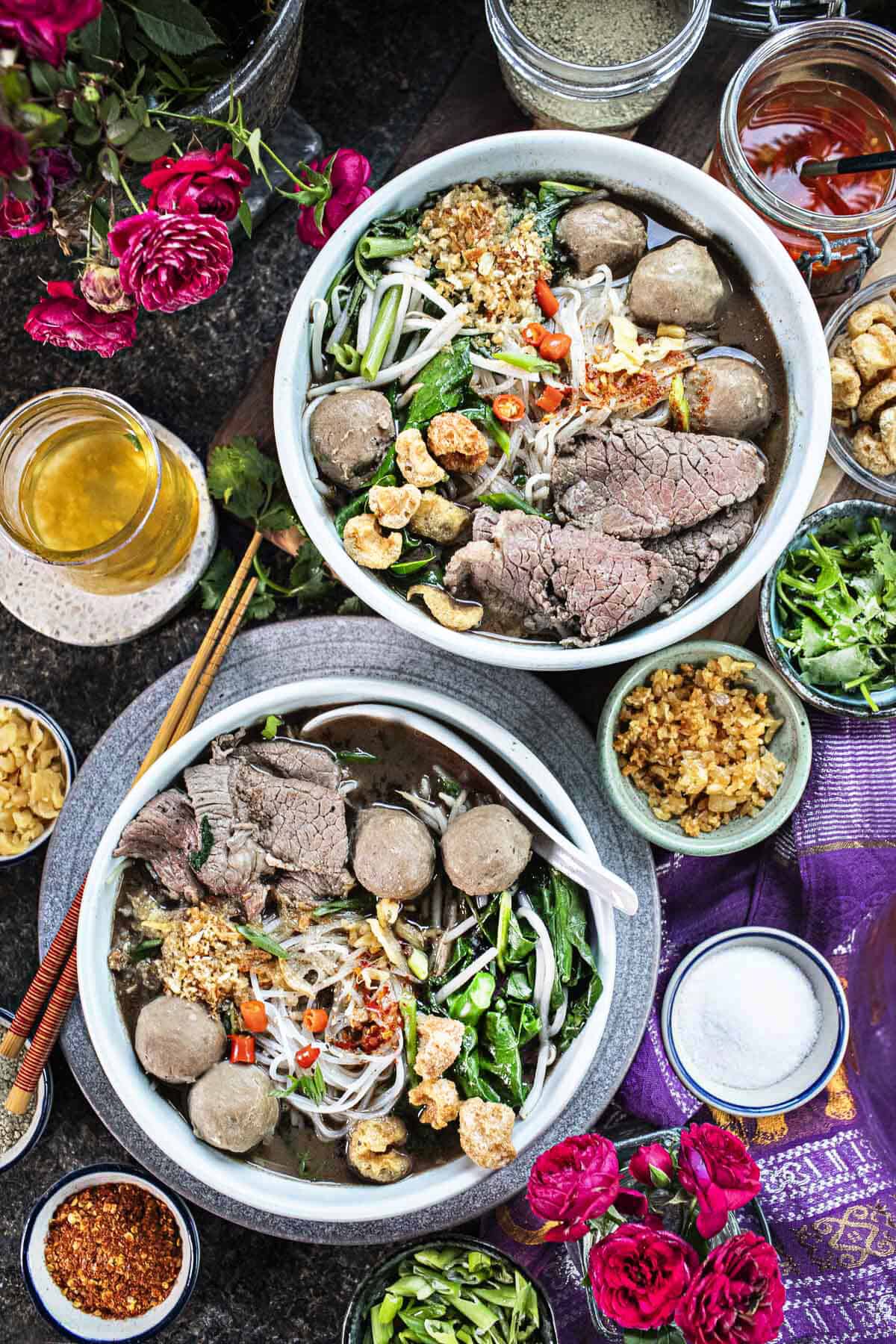
I grew up eating Guay Teow (Thai noodle soup), but boat noodles have always been my favorite. Whenever I return home, my first stop is at a local hawker stall for a steaming bowl of this amazing soup. It’s like a warm hug in a bowl—nostalgic and completely satisfying.
For more delicious Thai soups, enjoy these homemade recipes: Thai wonton soup, winter melon soup, Thai stuffed bitter melon soup, Gaeng Jeud Woonsen glass noodles soup, Yen Ta Fo-Thai pink soup, Tom Kha soup, and Kabocha squash soup.
Jump to:
- What is Thai Boat Noodles Soup
- Why You’ll Love Thai Boat Noodles Soup
- Thai Boat Noodle Soup Ingredients
- How to Make Boat Noodles
- Thai Boat Noodles Recipe Tips
- How to Serve Boat Noodles Soup at Parties
- Thai Boat Noodle Tools
- How to Store Boat Noodles
- Thai Boat Noodles FAQs
- Other Thai Recipes to Try
- Thai Boat Noodles Soup (Kuay Teow Reua)
- Related
What is Thai Boat Noodles Soup
Thai Boat Noodles Soup, or Kuay Teow Reua, is one of Thailand’s most beloved street foods, and for a good reason. It’s packed with bold flavors—spicy, savory, sour, and just a little sweet—all in a rich, aromatic broth. This dish has its roots in Bangkok’s floating markets, where vendors would sell tiny bowls of this flavorful soup straight from their boats. Today, it’s a street food staple and a must-try for anyone who loves big, bold flavors.
Authentic Boat Noodles Recipe
When I started hosting “Feed the Village” events in my village in Surin, Thailand, boat noodles became our go-to dish. It’s perfect for feeding a crowd because it’s simple to make in large batches and always a hit. On my recent trip to Thailand, I got to cook alongside the women in my village, watching them simmer the broth for hours. The aroma was incredible, and seeing everyone, from kids to elders, gather around to enjoy it reminded me why this dish is so special.
Don’t worry if you’re new to Thai cooking—this recipe is easy to follow and totally customizable. It’s all about layering those flavors and enjoying the process. Whether you’re making it for a family dinner or just want to try something new, Thai Boat Noodles Soup is your ticket to experiencing the comforting, vibrant flavors of Thailand right in your own kitchen.

Why You’ll Love Thai Boat Noodles Soup
- Ultimate Comfort Food: The slow-simmering broth fills your home with mouthwatering aromas, and every bowl of noodles feels like a warm hug on a cold day.
- Authenticity in Every Bite: Staying true to Thai culture, this recipe captures the bold, layered flavors of Bangkok’s bustling markets while allowing you to make it your own way.
- Choice of Pork or Beef: Customize your protein with thinly sliced pork, beef, or meatballs for a traditional touch that suits your preferences.
- Bold Flavors Made Easy: With just a few specialty ingredients, you can recreate this popular street food without the hassle.
- Perfect for Sharing: Boat noodles bring people together—serve them at a family dinner or gathering for a unique taste of Thai culture.
- Freezes well! Want a nice touch? Freeze any leftover broth for a quick fix whenever you’re craving a cozy, flavor-packed bowl of noodles.
Thai Boat Noodle Soup Ingredients
There’s a bit of a list here, but don’t let that intimidate you! Many of these ingredients are optional. You can mix and match based on what you find. Here’s everything you need for the broth, the bowl, and the toppings:
Ingredients for the Broth

- Pork bones: Neck or knuckle bones are great for flavor. I used pork neck and knuckle bones bought from my local Asian market.
- Water: You’ll need a lot for a rich, simmered broth.
- Pandan leaves: Adds a sweet aroma—look for these at Asian markets.
- Garlic: Both fresh and pickled garlic for depth.
- Pickled garlic and juice: The tangy brine adds a unique sweetness.
- Dry spices: Star anise, cinnamon sticks, cardamom, and peppercorns for warmth and complexity. Read more about spices used in Thai cooking here.
- Sweet Dark soy sauce is used for its sweet, deep color and umami flavor. Read more about the different types of Thai sauces here.
- Rock sugar: Adds just the right touch of sweetness. They are available in the Asian markets.
- Fresh pork or beef blood (optional): Traditional but optional for a more authentic taste.
What’s in the Bowl?

- Rice noodles (sen lek or sen yai): Choose your favorite type of noodles, but make sure they’re soft and pliable enough to soak up the hot broth. For dry noodles, soak them in hot water first. If you’re using fresh noodles, avoid overcooking them, as they can become soggy and break into short, overly soft pieces once submerged in the broth.
- Thinly sliced beef or pork: I usually choose thinly sliced beef, as it’s easier to find than pork in many places. Whatever protein you choose, slice it thinly so it cooks quickly in the steaming hot broth.
- Meatballs (pork or beef): These are a staple in Thai Boat Noodles and can be easily found in the frozen section of most Asian markets. Both pork and beef balls work great—pick your favorite!
- Bean sprouts: A classic addition, bringing a slightly sweet, crunchy texture. When preparing the bowl, these are submerged alongside the noodles. If you like, you can add extra fresh sprouts for a nice crunch.
- Morning glory (pak boong), Chinese broccoli, or spinach: These greens add a refreshing balance to the rich broth. Use whichever is available, and enjoy the added texture and flavor they bring to your soup.
Garnishes for Kuay Teow Reua

Think of these as your boat noodle garnish buffet—use as many or as few as you like. A little goes a long way, so feel free to customize your bowl to suit your taste.
- Fried garlic in garlic oil: Adds a fragrant, crispy kick.
- Green onions and cilantro (chopped): Fresh and zesty, these herbs enhance the overall flavor.
- Thai chili flakes: For those who love a spicy edge.
- Pork cracklings or pork rinds: A crispy, meaty crunch that’s a delightful addition.
- Pickled radish or Tung Chai: These are hard to find but worth it for their tangy-salty flavor. They are less commonly used in modern Boat Noodles and rarely seen in U.S. Thai restaurants.
- Ground white pepper: Black pepper works as a substitute.
- White granulated sugar: Just a pinch adds a subtle sweetness.
- Chili vinegar: A must-have for Thai soups, adding spicy, tangy complexity. (Check out my recipe!)
- Fish sauce: A little bit goes a long way to boost umami.
- Lime wedges: Squeeze fresh lime for a tangy, citrusy pop.
I know that's a lot of ingredients, but mix and match these garnishes to make each bowl your own!
Important Key Ingredients
These unique ingredients are worth mentioning as they add depth and flavor to the soup. All of them can be found in Asian markets.

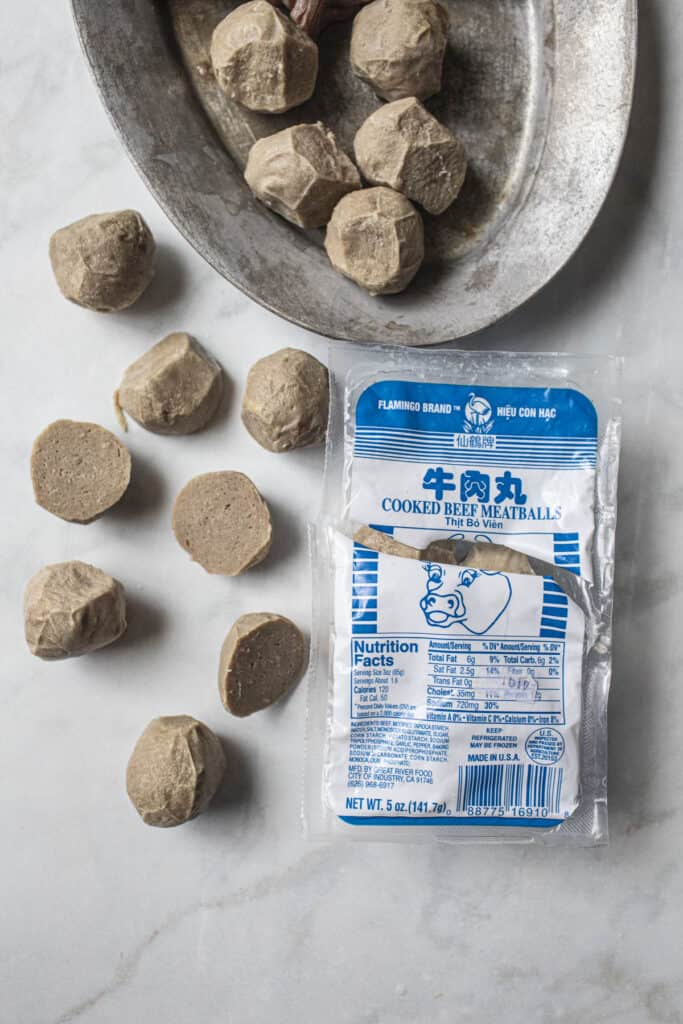

Blood
Fresh pork or beef blood (optional but key for traditional flavor) is what truly sets Thai Boat Noodles apart from other soups. It gives the broth its signature thick, dark color and a rich, umami depth full of iron. If you’re feeling squeamish, you can skip it, but for an authentic experience, I highly recommend trying it. Blood is difficult to find in the United States, so call ahead to your local Asian market or butcher to check availability.
In Thailand, "Nam Tok" refers to the addition of blood, while the lighter, blood-free version is called Kuay Teow Nam Sai ("clear broth").
Pickled Garlic
This comes in jars filled with briny liquid, which is a secret flavor booster in boat noodles. Don’t discard the brine—it adds a tangy-sweet complexity to the soup. Both the pickled garlic and its juice are key components.
Meatballs
Traditional boat noodles include tender beef or pork meatballs, which you can find at most Asian markets. They will be labeled as "pork or beef balls. I prefer either pork or beef meatballs for the boat noodles soup.
Type of Noodles for Gouy Teow Reau
Choose your favorite type—egg noodles, sen lek (small rice noodles), sen yai (large rice noodles), gouy chup (wide flat noodles), or even ramen. To avoid soggy noodles, follow the package instructions and soften them before dunking them in hot water.

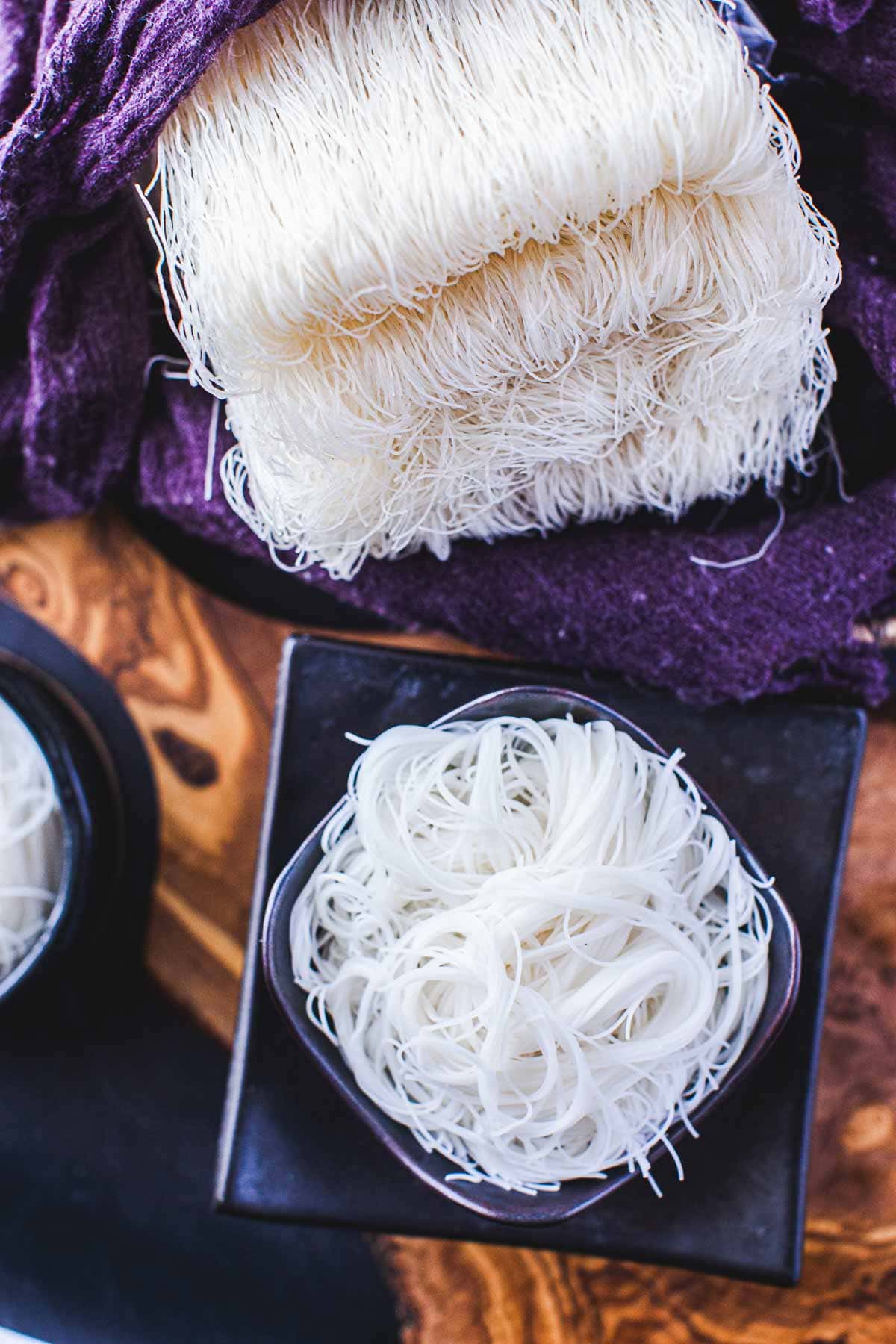
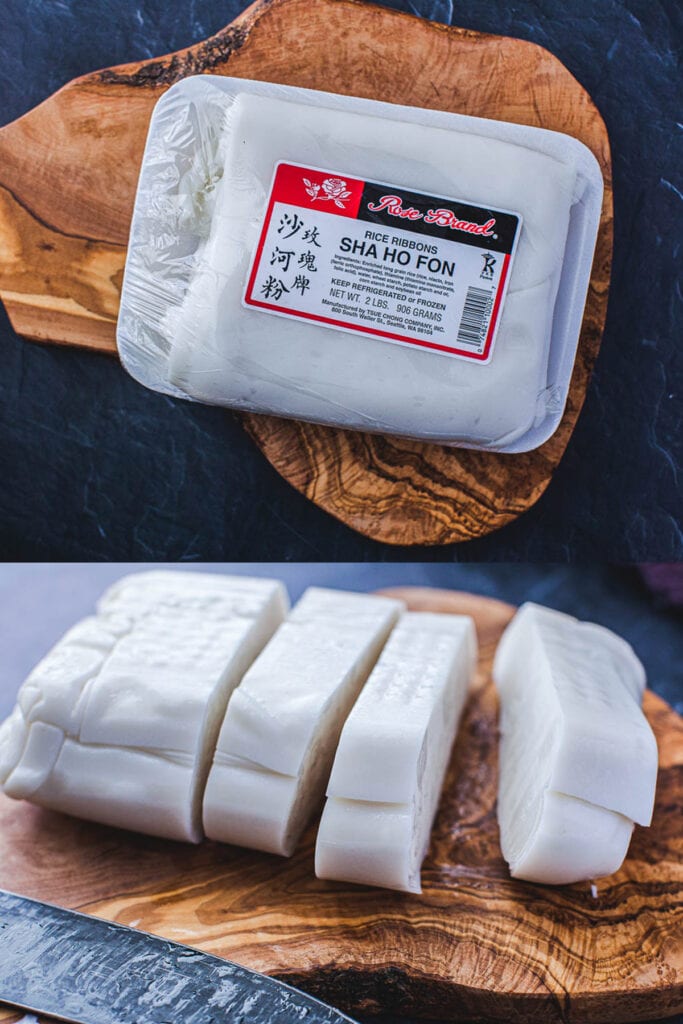



Read more about different types of Thai noodles here.
How to Make Boat Noodles
- Toast the Dry Spices. In a small, dry pan (no oil), toast the cinnamon sticks, cardamom, star anise, and white peppercorns over medium heat until fragrant. Toast the larger spices for a couple of minutes first, then add the smaller ones. Once aromatic, remove the spices from the pan and set them aside to cool.
- Prepare the Spice Sachet. Once the spices are cool, place them in a sachet along with pickled garlic, fresh garlic, and cilantro stems.
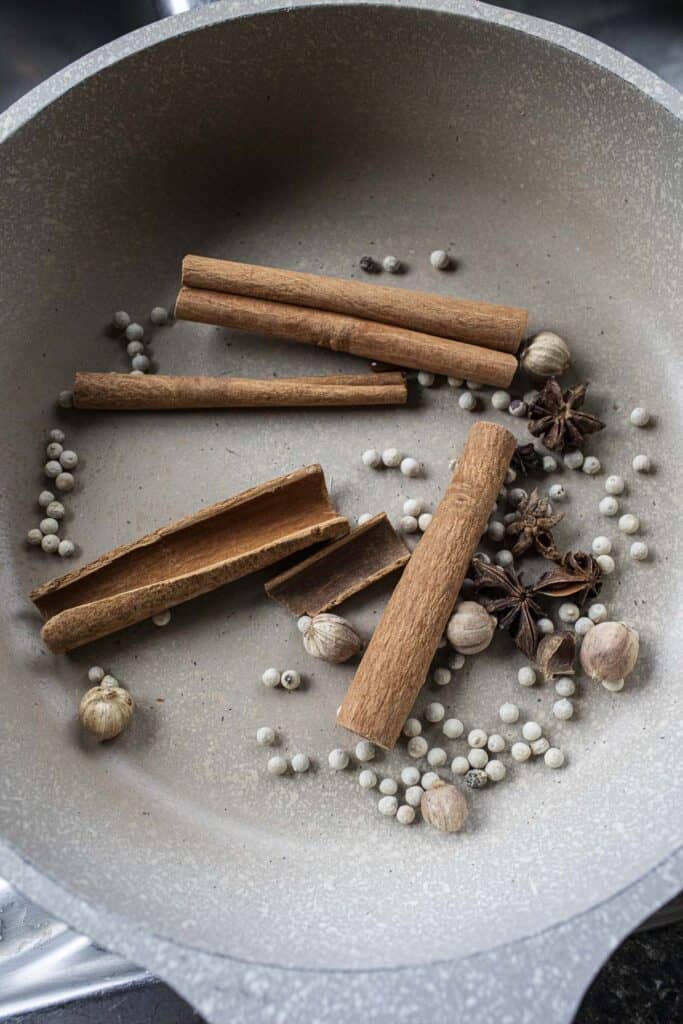

- Prepare the Broth. In a large pot (8-quart or larger), combine water, pork bones, rolled pandan leaves, salt, and daikon. Bring the mixture to a boil, skimming off any scum that rises to the surface. Reduce the heat and let the broth simmer for 2–3 hours to develop its rich flavor.


- Build the Flavor. About 1 hour before the broth is finished simmering, add rock sugar and soy sauces. Stir well and let the flavors deepen as the broth continues to cook.


- Prep the Ingredients. While the broth finishes, prepare the ingredients for the bowls about 30 minutes before serving. Soak the rice noodles in water until tender, then drain.
- Add the Pig's Blood. During the last 15 minutes of simmering, slowly stir in the blood while whisking continuously to prevent clumping. Taste the broth and adjust the seasoning with additional sugar or soy sauce as needed.
* You can leave the meatballs in the broth until serving, as Thai vendors often do to boost umami flavor.


- Prepare a separate pot of hot water for blanching. In a separate medium-sized pot, boil water over high heat. This water will be used to dunk the noodles, preventing the starch from clouding the soup broth. Vegetables and meat, however, can be cooked directly in the soup broth to enhance their flavor.
* For small batches of broth, it’s fine to cook the noodles directly in the broth—I’ve done it often with great results. This step is entirely up to you!
- Assemble the Bowls. Remove all the bones, herbs, and sachet from the broth. Use the meat from the bones to add protein to your bowls. Then, use a noodle basket to add about 1 cup of softened rice noodles to the bottom of each serving bowl. Submerge the noodles briefly in the boiling water pot, drain, and transfer them to the serving bowl.


- Blanch the meat and the veggies: Place sliced meat and meatballs directly into the soup broth to cook. Repeat with morning glory and bean sprouts or other greens in the same way. Once cooked, transfer them to the serving bowl.



- Ladle the Broth. Pour the hot, flavorful broth over the noodles and toppings in each bowl using a soup ladle. Adjust the amount of broth to your preference.
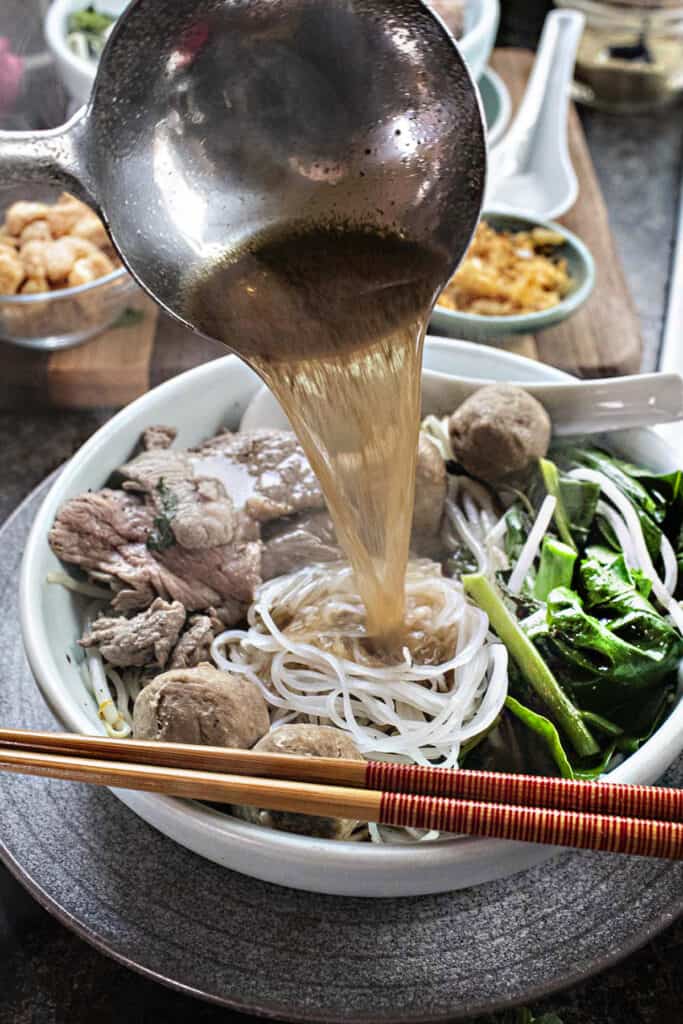

- Garnish and Serve. Top each bowl with fried garlic, garlic oil, green onions, cilantro, chili vinegar, sugar, chili flakes, and pork rinds. Finish with a squeeze of fresh lime juice. Mix well and enjoy your flavorful bowl of Thai Boat Noodles Soup!
Thai Boat Noodles Recipe Tips
- Focus on the broth, as it’s the heart of the dish. Use fresh pork or beef bones, simmer them for 2–3 hours to extract their full flavor, and skim off any scum to keep the broth clear and clean.
- Toasting the spices is another essential step. Dry-toast cinnamon, star anise, and cardamom in a pan until fragrant, but be careful not to overdo it, as this can make them bitter.
- When adding blood to the broth, pour it slowly while whisking to prevent clumping. Strain the blood first for a smoother texture. If blood isn’t an option, unsweetened dark soy sauce is sufficient.
- Preparing ingredients ahead of time makes the process smoother. Soak rice noodles until they’re soft, then drain them. Thinly slice your meats for quick cooking, and have vegetables like morning glory or spinach washed and trimmed.
- Always keep the broth and noodles separate—dunk the noodles briefly in boiling water before serving to avoid starch clouding the broth.
- Garnishes elevate the dish, so don’t skip them. Fried garlic, chili flakes, pork rinds, and a squeeze of fresh lime add the perfect finishing touch. Serving buffet-style lets everyone customize their bowl, making the experience fun and interactive.
- Rock sugar is a must for authentic sweetness, as it melts slowly and beautifully balances the flavors. Taste the broth as you cook, adjusting the seasoning to create the perfect harmony of flavors.
- For even better results, make the broth a day ahead. Refrigeration enhances the flavor, and you can easily skim off any solidified fat for a cleaner taste.

How to Serve Boat Noodles Soup at Parties
Serve your Guay Tiew in small bowls, just like in Thailand. If serving at a dinner party, Let guests customize their bowls with garnishes for a fun and interactive experience. Use chopsticks and duck spoons for the ultimate fun Thai dining experience!
Thai Boat Noodle Tools
These tools are especially helpful if you cook Thai food often. They’re versatile and perfect for dunking noodles, vegetables, meats, and herbs for a quick boil.
- A large soup pot (8 Quarts or More) is essential for making a big batch of flavorful broth. I also love my Dutch oven for this purpose.
- Soup Ladle: It makes it easy to scoop the hot broth over the noodles and toppings evenly.
- Spice Sachets: Keeps your spices contained while allowing their flavors to infuse the broth.
- Noodle Basket: Perfect for dunking and draining noodles, vegetables, and other ingredients without a mess.
How to Store Boat Noodles
Store the broth and toppings separately in airtight containers. Reheat the broth and assemble fresh bowls for leftovers. The broth freezes amazingly well, too. Separate the broth into small portions for a quick and easy thawing serving small size.
Thai Boat Noodles FAQs
It’s a savory-sour soup with rich broth, rice noodles, meat, and unique spices like star anise and cinnamon.
No, boat noodles have a stronger flavor, with ingredients like dark soy sauce and blood that set them apart.
Other Thai Recipes to Try
- Authentic Chicken Pad Thai Recipe
- Pad Kra Pao Recipe: Thai Basil Pork
- Gai Pad Med Mamuang: Thai Cashew Chicken
Thank you for visiting Simply Suwanee! If you enjoyed this recipe, share it with your friends, leave a review, or tag me on social media. Happy cooking!

Thai Boat Noodles Soup (Kuay Teow Reua)
- Total Time: 2.5 hours
- Yield: 8 servings
- Diet: Low Lactose
Description
This recipe for Thai Boat Noodles Soup (ก๋วยเตี๋ยวเรือ) comes straight from my village in Surin, Thailand—a dish that’s been made and loved for over 60 years. It’s the ultimate comfort food we’ve served to hundreds of people during festivals, special events, and family gatherings. And now, I’m so excited to share it with you!
Ingredients
- 2.5 pounds pork bones: I used a mix of neck and knuckle bones.
- 18 cups water
- 2 tablespoons salt
- 3 pandan leaves
- 6 cloves fresh garlic
- ⅓ cup cilantro stems, cut into 1-inch pieces
- 2 heads pickled garlic (1 ounce): Halve them if large.
- ½ cup pickled garlic juice
- 3 cinnamon sticks (about 4 inches each)
- 3 star anise
- 1 tablespoon white cardamom (6 pods) or 2 black cardamom pods
- 1 ½ tablespoons whole white peppercorns
- 2 tablespoons sweet black soy sauce
- 2 tablespoons Thai thin soy sauce
- 3 ounces rock sugar
- ⅓ cup pig’s blood
For the Bowl:
These are suggested amounts per bowl; feel free to adjust to taste!
- 1 ½ cups rice noodles, softened before dunking in the broth
- 4 ounces thinly sliced beef or pork
- 3–4 meatballs (pork or beef)
- ½ cup bean sprouts
- 1 cup morning glory (pak boong), Chinese broccoli, or spinach
Garnishes for Kuay Teow Reua:
Set these out buffet-style and customize each bowl to taste. Typically, just a dash of each is enough.
- Fried garlic in garlic oil
- Chopped green onions and cilantro
- Thai chili flakes
- Pork cracklings or pork rinds
- Pickled radish (Tung Chai)
- Ground white pepper
- White sugar
- Chili vinegar
- Fish sauce
- Lime wedges
Instructions
- Toast the Dry Spices. In a small, dry pan (no oil), toast the cinnamon sticks, cardamom, star anise, and white peppercorns over medium heat until fragrant. Toast the larger spices for a couple of minutes first, then add the smaller ones. Once aromatic, remove the spices from the pan and set them aside to cool.
- Prepare the Spice Sachet. Once the spices are cool, place them in a sachet along with pickled garlic, fresh garlic, and cilantro stems.
- Prepare the Broth. In a large pot (8-quart or larger), combine water, pork bones, rolled pandan leaves, salt, and daikon. Bring the mixture to a boil, skimming off any scum that rises to the surface. Reduce the heat and let the broth simmer for 2–3 hours to develop its rich flavor.
- Build the Flavor. About 1 hour before the broth is finished simmering, add rock sugar and soy sauces. Stir well and let the flavors deepen as the broth continues to cook.
- Prep the Ingredients. While the broth finishes, prepare the ingredients for the bowls about 30 minutes before serving. Soak the rice noodles in water until tender, then drain.
- Add the Pig's Blood. During the last 15 minutes of simmering, slowly stir in the blood while whisking continuously to prevent clumping. Taste the broth and adjust the seasoning with additional sugar or soy sauce as needed. * You can leave the meatballs in the broth until serving, as Thai vendors often do to boost umami flavor.
- Prepare a separate pot of hot water for blanching. In a separate medium-sized pot, boil water over high heat. This water will be used to dunk the noodles, preventing the starch from clouding the soup broth. Vegetables and meat, however, can be cooked directly in the soup broth to enhance their flavor. * it’s fine to cook the noodles directly in the broth for small batches of broth—I’ve done it often with great results. This step is entirely up to you!
- Assemble the Bowls. Remove all the bones, herbs, and sachet from the broth. Use the meat from the bones to add protein to your bowls. Then, use a noodle basket to add about 1 cup of softened rice noodles to the bottom of each serving bowl. Submerge the noodles briefly in the boiling water pot, drain, and transfer them to the serving bowl.
- Blanch the meat and the veggies: Place sliced beef and meatballs directly into the soup broth to cook. Repeat with morning glory and bean sprouts or other greens in the same way. Once cooked, transfer them to the serving bowl.
- Ladle the Broth. Pour the hot, flavorful broth over the noodles and toppings in each bowl using a soup ladle. Adjust the amount of broth to your preference.
- Garnish and Serve. Top each bowl with fried garlic, garlic oil, green onions, cilantro, chili vinegar, sugar, chili flakes, and pork rinds. Finish with a squeeze of fresh lime juice. Mix well and enjoy your flavorful bowl of Thai Boat Noodles Soup!
Notes
- Focus on the broth, as it’s the heart of the dish. Use fresh pork or beef bones, simmer them for 2–3 hours to extract their full flavor, and skim off any scum to keep the broth clear and clean.
- Toasting the spices is another essential step. Dry-toast cinnamon, star anise, and cardamom in a pan until fragrant, but be careful not to overdo it, as this can make them bitter.
- When adding blood to the broth, pour it slowly while whisking to prevent clumping. Strain the blood first for a smoother texture. If blood isn’t an option, unsweetened dark soy sauce is sufficient.
- Preparing ingredients ahead of time makes the process smoother. Soak rice noodles until they’re soft, then drain them. Thinly slice your meats for quick cooking, and have vegetables like morning glory or spinach washed and trimmed.
- Always keep the broth and noodles separate—dunk the noodles briefly in boiling water before serving to avoid starch clouding the broth.
- Garnishes elevate the dish, so don’t skip them. Fried garlic, chili flakes, pork rinds, and a squeeze of fresh lime add the perfect finishing touch. Serving buffet-style lets everyone customize their bowl, making the experience fun and interactive.
- Rock sugar is a must for authentic sweetness, as it melts slowly and beautifully balances the flavors. Taste the broth as you cook, adjusting the seasoning to create the perfect harmony of flavors.
- For even better results, make the broth a day ahead. Refrigeration enhances the flavor, and you can easily skim off any solidified fat for a cleaner taste.
- Prep Time: 30
- Cook Time: 2
- Category: Soups
- Method: Stovetop
- Cuisine: Thai
Related
Looking for other recipes like this? Try these:


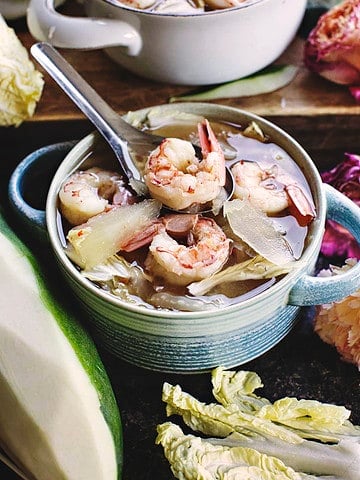



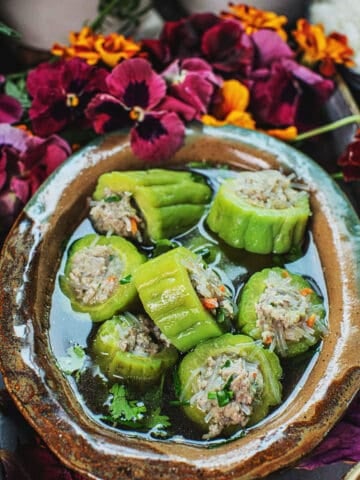
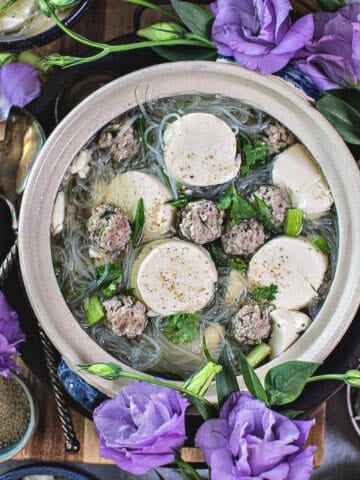
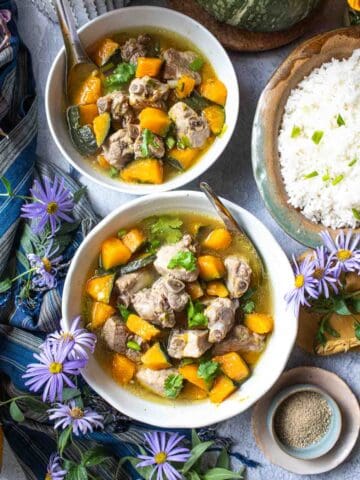
Alice Koh says
Wow!!! Suwanee, you did it again! I read through all the ingredients and meticulous step-by-step instructions and feel my mouth waters. I have NOT seen any recipe with such detailed instructions, tips and eye catching photos. Never used pandan leaves for flavoring in soup... Queasy about the pork blood but gosh! I bet these secret ingredients make this soup broth so unique. Time to publish a Simply Suwanee's recipe book <3
Angel K says
Literally the best of both worlds—-rich and full flavor yet warm and comforting at the same time. Just inhaling the scent of the broth felt nourishing to my soul. I was a bit under the weather and not super hungry but enjoyed a huge bowl of this soup. My soup followed the spices and other ingredients including the blood precisely. I had beef as my protein and the skinny rice noodles. I can not wait to make this again, especially with the cold winter temperatures upon us.
Mark says
I’m normally not a soup fan but I love this. Craving it right now actually. Tasty tasty tasty!!!